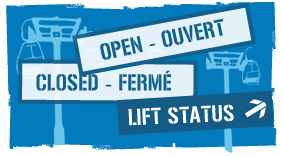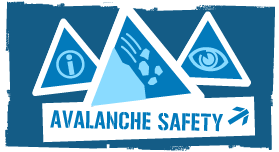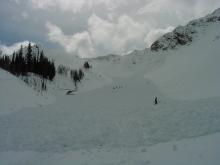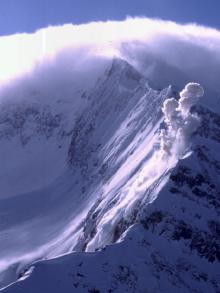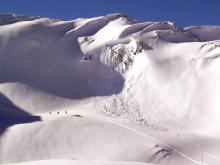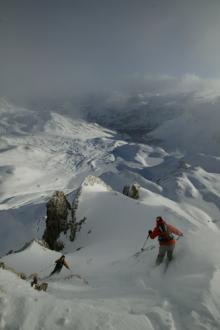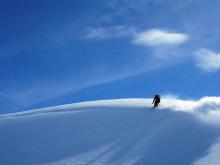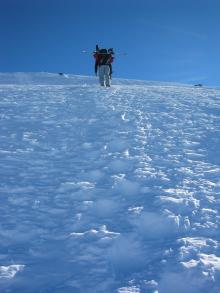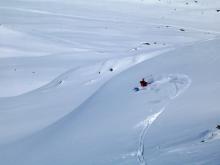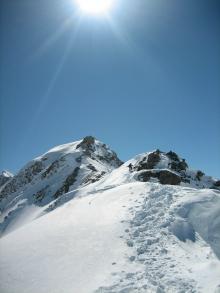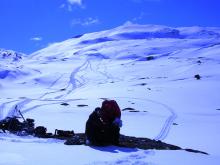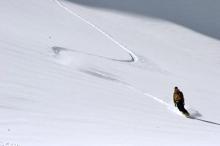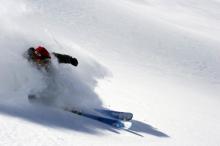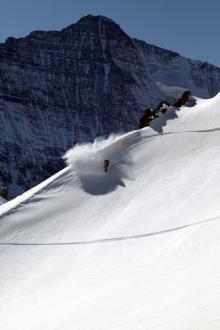Chased by the Dragon. by Fred Foxon 1996.
"Chased by the Dragon"
"Breathe slowly - get calm - stop panicking. Reduce your oxygen demands - you'll last longer." Somehow, a tiny corner of reason continues to offer good advice. Meanwhile, the terror which has overtaken me remains impervious to its entreaties. Blood pounding, breathing at 120 gasps a minute, whatever's now in charge doesn't give a damn about good advice.
Twenty five minutes earlier, I was riding the chair with Chris and Suzanne. It was a chance meeting on a beautiful day of blue sky and fresh snow. Not having seen each other in over a year, we send our groups up ahead and spend the 10 minute ride exchanging news.
Chris is taking his group over to Tignes to ski the off-piste; I'm heading the same way, but on a more roundabout route. My group are all keen, experienced powder-skiers. The route is mentally sketched out, on the premise that it should be a memorable day's skiing for a more than normally discerning group. Exactly how memorable I fail to anticipate.
I say goodbye to Chris and Suzanne, take the group through a warm-up and stretch, then lead off down Cretes to the top of Combe Folle. We hang a right onto the Val d'Isère side of the saddle, then cut left under the rope. After making sure everyone is clear on safe movement on the traverse, we set off across the face. Half-way over, I realise my first mistake of the day - I've forgotten to check that the avalanche transceivers are switched on.
Sure - the group are all experienced, well-practised off-piste skiers; most have their own transceivers. Stop in a safe place to check - yes, they're all on. Except me. It's the first time I've made that mistake in over 7 years. What is it about this day, this group, this run? But no - that question only comes later. Right now, it's simply surprise and self-anger, that I've forgotten something so basic and so vital.
As it is, the face we've just traversed is fairly low-risk. Not that it couldn't slide, just that the traverse itself is so well consolidated that unless anyone strays off it, it's unlikely to go. In these conditions, the main danger comes from higher up. Luckily there's no-one up above us on the face.
At the end of the traverse, the ridge cuts back at right-angles. Several steep gullies lead down into the broad-floored combe below. "OK guys - stay back on the ridge. I want to check this one out before we ski it".
My second mistake. Gut reaction says I don't like it. Intellect says let's try to prove gut reaction wrong. It's steep - maybe 35º at the top - and fairly narrow. The overall profile is favourable - uniformly concave from top to bottom. The snow's in compression, and therefore less likely to fracture than with a convex profile. Five or six tracks already lead down it - meaning little or nothing. They're yesterday's skiers, yesterday's conditions.
It's not a lee slope, so there's no major slab build-up. But the gully lies across the prevailing wind, so there's a significant build-up on the left-hand wall. There's also a lot of snow in it - too much to dig a pit. A full-depth profile is the only way to get a reasonably clear picture of the slope's stability.
Instead, I decide to use a pole-probe. With 115cm. poles, that gives a good 1 metre probe. Push it down to the handle, then draw it slowly upwards. A firm, even resistance, with no sudden discon-tinuities. Feels good. Check it out with a jump test - crude but reasonably effective. Jump high in the air and land as hard as possible across the slope, to see if it cracks, slumps or breaks away. Choose a safe(ish) place in case the whole lot goes. Nothing. Solid as a rock. Try again - once more, no movement.
It looks good - heavy powder a couple of days old rather than soft slab; a concave profile; the steepest top section wedged above a narrow neck formed by rock outcrops on either side; below that a wide open, concave snowfield free of obstructions or hazards. Final evaluation - the slope's safe to ski, but steep. If anyone falls and loses a ski, it's likely to stop before they do, leaving a stiff climb to retrieve it. In response I decide to tail-end the group, to bring down anything that gets left behind.
"We're going to ski it one at a time - down the centre of the gully till you're below that outcrop on the left, then hang a left till you're beneath it, well away from the natural fall-line in case anyone tumbles. If anyone falls and loses a ski, I'll bring it down". Graham's fired up, ready to go. Skis it well, with a powerful extend-retract to suck the skis out of the heavy base layer of old snow. "OK - he's down and parked. Who's next?"
One by one, each of the group sets off - skis it solidly and well, parking out to the side about 100 metres below where I stand. "OK, Tim - as soon as you're ready". A moment later, Tim's sliding in alongside the rest of the group. Trevor's just taken off his jacket to remove an extra layer of clothing. The rest of the group stand in the crisp sunshine, enjoying the view, reviewing those first few turns of the day. Time to leave my vantage point and join them.
First turn's a right-hander - snow's heavy but consistent, needing a strong unweighting to initiate it, but then steers smoothly through the rest of the arc. Turn two - got the feel of the snow, re-bounding easily from the first. I'm a little to the right of the gully's centre-line, just above some rocks. Traverse a little, then into turn three. Need to kick off harder on this one, as there's no rebound. Pole-plant, up, and.......
No quick, shrieking terror, this; rather, a slow, gut-churning horror as I realise what's happening. Looking up over my left shoulder as the turn begins, I see the slope beginning to bulge, right up to the summit ridge 20 to 30 metres above. Like the smooth ocean heaving itself up into a roller, that instant impression reveals a not-yet-cresting wave of 30 tonnes of snow breaking loose above my head.
That momentary glance conveys volumes. Not just the fact of the avalanche, but also its scale and seriousness. Alongside a sense of wished-for unreality is the realisation that this is not just dangerous, it's deadly. But for now there's no time to contemplate mortality - not yet, not for another 15 seconds - as the pace of events accelerates.
Two days later, returning to the spot, I stand beside the fracture line and look down the gully. Would I consider straight-lining it? No way. But in that frozen moment of realisation, only one idea prevails - stall the turn in the fall-line, take it straight, the faster the better, get the hell away from this lethal juggernaut bearing down from above.
The next instant, I'm rooted to the spot. Not the frozen time-frame of adrenaline-expanded reality - I'm physically wedged between two huge slabs of snow. From my ski boots forward I'm standing on the downhill slab; the one uphill and behind me has ridden up over my ski tails, making it impossible to move or even fall over. The first of many chances that save my life. If I'd fallen at that point, I'd have been under all those tonnes of moving snow.
At the same time I realise I'm locked in place, I also realise I can't see. Everything's gone white, like being inside an illuminated ping-pong ball. First reaction - somehow my sunglasses have got covered with snow as the slope fractured. Still holding my poles, I hook my thumbs behind the frames and flip them off. Everything's still white. For a crazy instant I think that somehow my contact lenses have misted up, then sense prevails and I recognise that I'm inside the snow cloud kicked up as the avalanche released.
Throughout this surreal interlude, I'm aware of bumping and rumbling as the slab I'm standing on trundles downhill. There's no indication of speed, except that the ride is getting rougher; nor of duration, as each adrenaline-heightened impression dilates in time. The whole brief roller-coaster ride probably lasts between 3 and 5 seconds; in the midst of the emerging maelstrom it seems like minutes.
Suddenly, as if thrown by a giant hand, I'm hurled headlong forward, pitched over the tips of my skis as the slab fractures and disintegrates. In the shock of the moment, my first impression is of relief - I've ejected cleanly from both skis, reducing the danger of wrenched and broken limbs in the boiling mass of snow. Second dice-roll.
Simultaneously I realise I'm tumbling - spinning head over heels like a thrown stick as the avalanche accelerates downhill. Trapped inside this whirling rush, alongside the disorientation and impotence, a corner of reason says, "tuck into a ball for protection".
Apart from minimising the leverage forces which can be imposed on out-stretched limbs, it gives the added protection of the "muesli-jar" principle - shake the jar and the bigger bits accumulate at the top. By tucking into a compact ball, with luck I'll be one of the bigger bits and stay nearer the surface.
But because of my speed of rotation, it's hard to tuck in tight. The centrifugal loading on my limbs, coupled with the viscosity of the aerated snow-mass inside the avalanche, demands a huge effort to achieve that simple task. And as I tuck, the rate of spin speeds up yet more.
What at the time serves only to disorient is probably also life-chance number three. Lying prone within the snow-mass, the likelihood is to be pushed down and submerged beneath the debris. As it is, spinning and tumbling like a rotor keeps me high within the turbulent upper layers.
As before, sense of duration is impressionistic rather than metric. This period of tumbling lasts long enough for me to recognise the situation and attempt to respond to its dangers. Thereafter it continues to the point where my only thought is "please, I'd like this to stop now". In reality, it's probably less than ten seconds.
Then suddenly, rotation stops as I land heavily on my back. Almost instantly I'm mentally reoriented - I'm lying flat on my back, head downhill, legs straight out and arms spread-eagled. A dull, amorphous whiteness means I can't be very deep. The snow is still avalanching over me, but its growling roar subsides; a silky hiss whispers into silence. "OK - now!" Maximum effort, to break free or at least create an airspace before the debris settles and compacts.
Maximum nothing. I can't move a muscle. Like a fly in amber, I'm trapped in an enveloping, suffocating mass. The still-avalanching snow has pushed into my nose and mouth, blocking my airway as far as the back of my throat. And in that hanging moment of stillness, realisation strikes. Having survived the avalanche uninjured, I'm trapped, suffocating, four minutes from the onset of brain damage and eventual death. No way anyone can find me, release me in that time. Recognition, resignation - the image of my children, whom I'll never see again.
That final impression marks the last moment at which rational thought has any bearing on events. A detached observer remains, but unable to influence action. For with the realisation of dying comes a raging, overpowering panic.
An adrenaline-empowered urge to survival starts wrenching my head back and forth within the snow. Heaving, straining with a power which rational will could never achieve, the debris compacts fractionally. The blind craving of asphyxia repeatedly drives my face and forehead against the snow, desperately struggling to make it yield.
At last, lungs bursting, there's space - maybe half an inch in front of my nose and mouth. Enough stale air in my lungs to cough out the plug; gasp at the oxygen-bearing air; choke as loose snow sucks back into my airways; head-butt the snow again to compact it further; gasp for life.
As I realise I'm still alive, mindless panic retains control. Rational thought is reciting good advice: "OK - you're not dying, you've got air. Calm down, slow your breathing; minimise your oxygen demands and you'll survive longer".
To no avail. In heaving panic, ribs straining against the pressure of unyielding snow, it feels like my chest is encased in concrete as I desperately gasp for breath.
Despite the snow's immobilising grip, I suddenly realise I'm not completely trapped. My right arm is horizontally outstretched and held fast, but my left extends upwards, fingers free. I'm less than an arm's length beneath the surface.
Scrabbling, wriggling, enough space now to move my wrist. Bend my hand down, fingers scraping at the snow above my face. Straining arm and wrist, the hand digs downwards. The effort shifts the snow, collapsing it back against my face. Resurgent panic, smash my head against the snow, gasp for breath. A repeating cycle, as the scrabbling fingers continue to strain downwards, until my wrist is bent to its limit. And still nowhere near to clearing my face. Perhaps only 20 or 30 centimetres now separate fingers from face, but it could be half a mile. There's no longer any direction my hand can reach to scrape at the snow.
Throughout this futile interlude I continue gasping twice a second. Still no control, no influence of reason over emotion. Then - at last - sound, movement, voices. Throughout the burial I have been so centred upon my own survival - so engulfed in my own terror - that I have barely thought of the others. The prospect of eventual location and release has been submerged beneath the weight of snow and fear, crowding out all other thoughts.
But now, the sound of a shovel in snow; the gradual easing of the pressure and constriction of my abdomen and chest; voices calling. And with that recognition of imminent release comes another release - of all the pent-up terror of events. I'm shouting and swearing, cursing the great grinding, roaring bastard that did this to me. Terror transmuted into anger, as if the avalanche had life, animus, malevolent intent.
God knows what those on the surface think as they hear me - screaming out in injury and pain? How carefully must they dig to avoid hurting me more? And all the while without a scratch, the oral autopilot soldiers on, blaspheming its way towards the surface.
Even this, the period of rescue, seems to last an age. In my desperation for release from this claustrophobic, engulfing shroud I wouldn't mind being hit by a shovel. But as it is, the pressure gradually eases as snow is dug away from my abdomen and chest; slowly and delicately it is cleared from over my face. Blinking against the sudden sunlight, my eyes adjust and focus. Surprisingly after all the buffeting, my contact lenses are still in place. My first impression is of Graham, shovel in hand, looking anxiously down at me. "Are you OK?" "Yeah. I think so. Just get me the hell out of here". My left arm's free, while my right arm and both legs are still firmly embedded in the debris. He grabs my wrist and pulls. Slowly, reluctantly, as if being dragged from quicksand, I'm released. I climb from the hole and absorb my surroundings.
It takes a moment to recognise where I am. Knowing I've been carried some way downhill doesn't prevent the shock of discovering just how far. The spot where the group had parked is 200 metres above me; the point where the avalanche caught me another 100 metres above that.
Afterwards, the group and I try to establish how long it took from the moment the avalanche released to when it stopped. The consensus is between 10 and 15 seconds. So my average downhill speed was between 40 and 50 miles per hour. On reflection, I realise why the snow was so densely packed. The distance over which the avalanche and I slowed to a standstill was no more than around 10 metres. In other words, the deceleration force was over twice that of gravity. It stopped me about 3 times faster than a car in an emergency stop. At that rate of deceleration, the air gets squeezed from the snow like water from a sponge, packing the debris into a solid mass as it comes to a halt. No wonder I could barely breathe.
Meanwhile, I climb out of the hole and get to my feet. As soon as I'm standing, the first of the pisteurs arrives on the scene. "Is anyone still missing?" I quickly scan the people scattered around. An ESF instructor stands nearby. It was he who called up the rescue services on his radio. One of his pupils has come to witness my disinterment. A further glance reveals that all 6 of my group are present. When I set off on my descent there were no skiers on the face below the gully. Everyone's accounted for. "No. No-one's missing." He immediately speaks into his radio, calling off the SAF helicopter which at that moment is circling in to land. It banks sharply and veers off, back to its base in the valley. Moments later a snow-cat arrives, carrying a fully-equipped rescue team. Given that I was buried for no more than 10 minutes, it's impressive how fast these resources have been mobilised.
I notice that Tim doesn't have his skis. It seems that not everyone saw the avalanche release. Once it was past the narrow neck of the gully, it fractured outwards, sweeping towards the group.
Five were already facing away from the gully centre. Four immediately pushed clear, but by the time Tim saw it the avalanche was bearing down on him like an express train. He was blown clean out of his skis, and body-surfed the debris for about 200 metres. Luckily the avalanche spat him out to one side as it crested a small ridge. He came to rest buried only up to the waist, and was able to extricate himself.
Trevor too was caught. He still had his jacket off and was facing towards the gully as the avalanche released. He had to kick-turn before pushing himself clear, and was caught up in the outermost edge of the debris. The force wasn't great enough to knock him over, but he was carried a few metres downhill and his skis wrenched off.
In all, Tim and I lost our skis and poles, while Trevor recovered all of his possessions. Under the circumstances, we all got off incredibly lightly. Due to the loss of our equipment, Tim and I were taken by snow-cat back to the nearest café, where the pisteurs recorded full details of the incident.
Two days later the group and I return to the scene, to confront and learn from what happened. Looking down over the avalanche from the summit ridge, I first see its true scale. Sweeping out in a shallow fan, its furthest edge is 400 metres below the fracture line; in width, it extends 75 metres across the slope. Suddenly a tiny feature catches my eye. About 300 metres below, towards the right-hand edge of the avalanche track is a small hole. An eerie, dislocated sensation grips me as I look down into the open mouth of the grave from which I was so recently exhumed.
Premonition or perception - reality skewed by a fractionally different turn of events. Rational hindsight stacks up the facts, confirming but not informing what is revealed by raw, immediate experience. Too many chances, too many rolls of loaded dice. I could so easily have died there.
On the face of the evidence, I should have died there. The fact that I was well below the fracture line when it released, with many tonnes of snow above me; the avalanche-stripped rocks, over which I had somersaulted without a scratch; landing face-up rather than face-down, my rucksack buoying me closer to the surface where otherwise it might have served to push my head deeper; being in any case so close to the surface that I was quickly located and rescued (and even half a metre under, I was lucky to survive).
I'm aware that I'm breathing faster, just gazing over what was and what might have been. Looking away, another feature catches my eye. The fracture where the avalanche had released. The pisteur who arrived on the scene just as I emerged from the debris had told me how deep it was, but at the time I hadn't taken it in. Now with a jolt, I see that he wasn't exaggerating. Almost full depth, the snow has released along a 2-metre deep crown-wall. The improbability of survival is magnified yet more. After a moment more surveying the scene, I need to get out of there. Instead of absorbing morbid images, I need a more practical focus. We skirt the end of the ridge, to come in from the side of the avalanche gully 150 metres lower down. I want to find out why it released, what I'd missed 2 days before.
It doesn't take long to find. Here on the shallower gradient of the open slope below the gully, the surface snow has been stripped off, but not to as great a depth as higher up. The overall snowpack is shallower anyway, as less snow has accumulated than in the narrow confines of the gully itself. Digging down, I find a loose, rotten layer close to ground level.
Dynamic changes within the snow-pack have caused a wholesale migration of some of its substance, leaving an open, porous airspace surmounted by a coarse, granular layer. It doesn't even need a magnifying glass to identify these crystals. The biggest are about 4mm in diameter; their hexagonal, hollow shapes are unmistakable.
Depth hoar - an unseen, fragile hair-trigger lying deep within the snow. Caused by a period of intense cold, these crystals might have formed a month ago or more. Since then, like an anti-personnel mine they have lain in wait for the additional loading of an unsuspecting skier or snowboarder to release their tenuous hold.
None of the checks I'd done had identified its presence. Only a full-depth snow-pit would have sufficed. The alter-native, relying on inference rather than observation, is to have had a detailed knowledge of the pattern of weather and snowfall throughout the season. Can I get myself off the hook of responsibility for failing to identify it? Certainly it isn't realistic to dig a full-depth snow-pit on each slope before it's skied. But I'd been in resort for 3 weeks, and hadn't sought out as much detailed information as I ought.
In the final analysis, I'd screwed up - missed vital signs, or failed to check for them. As a result, I'd nearly got my self killed, and exposed my whole group to danger.
Afterwards, people asked if I had nightmares about it. In fact, no. But I can no longer spend a day in the mountains without hearing the crack or seeing the fracture and bulge of ominously releasing snow. And my real, waking nightmare is that it wasn't me in there - that it was one of my clients, maybe less experienced, maybe less lucky, maybe now dead.
It's that thought, that image which now haunts the mountains. A place of joy and beauty, now twisted and transformed. I'd long recognised its dangers - the austere, deadly beauty of the high peaks. But now I can no longer maintain a balance between these qualities. For now, I wish to inhabit a different world.




